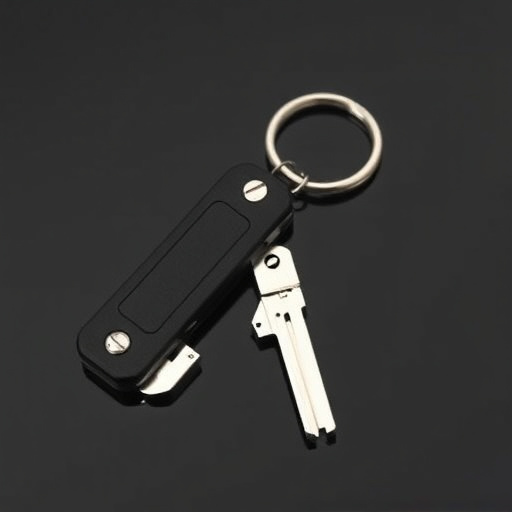Before acquiring a self-defense keychain with metal knuckles, understand local laws regarding keychain weapon permit requirements. These vary significantly by region, demanding background checks, training certifications, and proof of valid reason for carry. Adhering to these guidelines ensures legal boundaries while enhancing personal safety in unforeseen situations.
“Enhance your personal safety with a self-defense keychain featuring metal knuckles—a compact, powerful tool designed for emergency situations. This comprehensive guide explores the legalities of carrying keychain weapons, delving into the design and functionality of these tactical tools. We’ll uncover effective self-defense strategies, provide tips on choosing the right model, and discuss training and permit requirements, ensuring you’re prepared and responsible. Navigate the world of keychain defense with confidence.”
- Understanding Keychain Weapon Legalities
- Metal Knuckles: Design & Functionality
- Self-Defense Strategies with Keychain Knuckles
- Choosing the Right Self-Defense Tool
- Training & Responsibilities for Carry Permits
Understanding Keychain Weapon Legalities
Before considering a self-defense keychain with metal knuckles, it’s crucial to understand the legalities surrounding keychain weapons in your region. Each jurisdiction has specific permit requirements for carrying such devices, so it’s essential to research and comply with local laws. Keychain weapon permit applications often involve background checks, training certifications, and proof of valid reason for carry, ensuring responsible use.
Understanding these legal parameters is key to avoiding legal repercussions. In terms of keychain weapon permit requirements, you may need to demonstrate self-defense needs, personal safety concerns, or a history of facing threats—all while proving your ability to handle the device responsibly. This process varies widely by location, so staying informed and adhering to local guidelines is paramount.
Metal Knuckles: Design & Functionality
Metal knuckles, as the name suggests, are a compact and discreet self-defense keychain that houses a set of metal prongs designed to cause pain and disorient an assailant. This simple yet effective concept has been around for centuries but has evolved in recent times with modern materials and designs. The traditional knuckle duster has undergone a transformation, now often crafted from durable metals like stainless steel or aluminum, offering both strength and lightweight convenience.
The functionality of metal knuckles is straightforward; their primary purpose is to provide a swift and powerful defense mechanism when faced with a potential attack. The keychain design allows for easy carrying, ensuring that you have access to a self-defense tool in various situations without the need for additional permits or restrictions, unlike some other keychain weapons that may have specific permit requirements.
Self-Defense Strategies with Keychain Knuckles
Carrying a self-defense keychain with metal knuckles can be a powerful tool for personal safety, especially in unforeseen situations. These compact devices offer an added layer of protection and are easily accessible, allowing users to defend themselves quickly if needed. When utilizing a keychain weapon, it’s crucial to understand the permit requirements associated with such items. Many regions have specific laws governing the carriage of hidden weapons, and adhering to these legal guidelines is essential for responsible self-defense.
Knowing your local regulations regarding keychain knuckles ensures you remain within the law while empowering yourself. While some areas may permit concealed carry with a simple permit or registration, others might demand more stringent licensing. Familiarizing yourself with these requirements empowers you to use your self-defense tool legally and effectively, providing peace of mind in potentially dangerous situations.
Choosing the Right Self-Defense Tool
Choosing the right self-defense tool, like a keychain with metal knuckles, involves understanding both its capabilities and limitations. Firstly, consider your personal safety needs and situations in which you might need it. For instance, if you frequently walk alone at night or have a history of encountering potential threats, a compact and easily accessible keychain weapon could offer peace of mind. However, remember that no tool can replace situational awareness and avoiding dangerous encounters whenever possible.
When selecting your keychain defense option, also keep in mind the legal aspects, including local laws and regulations regarding keychain weapons permit requirements. Different regions have varying rules on what constitutes a legal self-defense tool, so ensure you’re aware of these restrictions to avoid any legal complications. This includes understanding range, durability, and the level of force the device can deliver—all factors that contribute to its effectiveness in real-world scenarios.
Training & Responsibilities for Carry Permits
Obtaining a permit to carry a keychain weapon, such as metal knuckles, involves understanding and meeting specific training and responsibility requirements. These permits are subject to strict regulations that vary by jurisdiction. Before applying, individuals should complete authorized self-defense courses that teach not only the physical techniques but also legal responsibilities and ethical considerations.
The process often includes background checks, practical demonstrations of proficiency with the device, and a thorough understanding of local laws regarding defensive use. It’s crucial to remember that carrying any weapon comes with significant responsibilities, including knowing when and how to use it legally and ethically. Adhering to these requirements ensures that individuals are prepared not only to defend themselves but also to act responsibly in public spaces.
When considering a self-defense keychain with metal knuckles, it’s crucial to balance functionality and legality. Understanding local keychain weapon permit requirements is essential, as these tools can be powerful but come with responsibilities. With proper training and responsible carrying, individuals can empower themselves while navigating the legal landscape of self-defense options. Choose wisely based on your needs and always stay informed about relevant laws to ensure safety and compliance.
